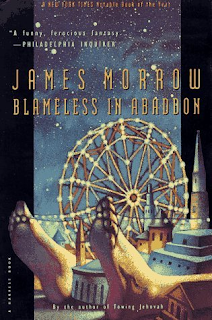Blameless in Abaddon by James K. Morrow
Hello, Stranger.
Primary Driver: (Plot, World, or Character)
Bechdel Test: Pass
Technobabble: Minor.
Review: A brilliant short story which far overstays its welcome. Feels like an introductory theology class by a disaffected tween. Lots of clever and funny moments, including the creation of a theme park around God's comatose body - but not enough to carry a story. Also relentlessly miserable at points. This is not so much a novel as a point to prove: and the point is reiterated to death.
Martin spent the rest of the day and all of the following morning filling the record with microbes from the Kroft Museum’s maleficent zoo. The diphtheria bacterium. The cholera bacterium. The smallpox virus. The measles virus, still racking up an annual body count of 880,000. HIV, presently responsible for 550,000 deaths each year. Plasmodium, the malaria protozoan, currently occasioning 1,000,000 corpses per annum.On Tuesday afternoon Randall took over the task of recording what he called »the biological weapons deployed by the Defendant in His relentless war on humanity.« People’s Exhibit A-27 was a two-foot-long plastic model of the mosquito Aedes aegypti, vector of the dreaded yellow fever virus. Holding the model in his lap like a pet, Carbone explained that from 1793 to 1798 yellow fever killed about 12,700 British soldiers in the French colony of Saint Domingue. Exhibit A-31 was a loaf of bread made from rye contaminated with ergot, a disease caused by the fungus Claviceps purpurea. In 1722 nearly 20,000 Russians died in excruciating pain after eating ergot-contaminated bread. Exhibit A-34 was a cloth face mask worn by a San Francisco dock worker during the great influenza epidemic of 1918 – 1919. The masks did no appreciable good, but the city fathers still made them mandatory. Worldwide death toll: 22,000,000.On Wednesday morning Martin returned to the lectern, a piercingly familiar object now; he knew its every nick and whorl. He put aside the tiny universe of pathogens and began addressing the larger-than-life fact of planetary upheaval, leading the judges through the Chamber of Earthquakes and Volcani c Eruptions.People’s Exhibit B-1 was the fractured skull of a child who’d been crushed along with 20,000 other victims by the great Spartan earthquake of 464 B.C. Exhibit B-9 was a smashed bell from a Byzantine church destroyed by the quake that leveled Antioch in A.D. 526, killing 150,000 Christians. As the day wore on, Martin stepped up both the pace of his presentation and the audacity of his rhetoric, using Kroft artifacts to document how the Defendant had »inflicted His seismic wrath« on forty-eight separate population centers between 1456 and 1999. The great Lisbon earthquake of 1755, which did so much to nurture Enlightenment skepticism concerning divine justice, slaughtered 75,000, including hundreds of worshipers gathered in the cathedrals for All Saints’ Day services. The worst disaster in the history of Peru occurred on May 31, 1970, when a powerful quake shook the region around Chimbote. The debris, ash, and subsequent famine claimed 60,000 lives and orphaned 5,000 children.
The Trial of God is effectively just page after page of horror spelled out. Does it make the point that horrible things have happened? Yes, of course. Would anyone out there have disagreed with the proposition that lots of terrible things have happened? Probably not. It feels like Morrow is punishing the reader for sticking around.
We're also now in comfortable spoiler territory. Towing Jehovah had a clever core: this seems to have begun as a series of rejected short stories. The first is the story of Celestial City and the monetization of God's demise. The second is the Trial of God. And the third is the absolute madness of the exploration of the world within God's corpse. Arguably there's another about Satan's life after God's death, but that already feels tacked on here.
Any one of these could - maybe - have been turned into a decent story. As it is they are all both underdeveloped and overexplained. Everyone communicates in expository monologues. We're informed of plenty of things without them having any weight. There is simply nothing to it.
A few words in defense of this whole thing. I am undoubtedly the exact wrong audience for this. There is a big reveal at the end:
»I am what I am. I am Christ and Antichrist, God and Satan, Heaven and Hiroshima, Arcadia and Auschwitz.« Smiling devilishly, Sarkos lumbered up to Lovett. »Get it, fat boy? God is a duality. Dr. Jehovah and Mr. Hyde.« He lobbed the bottle cap into his mouth and chewed. »Allow me to tell you a bedtime story. It’s called ’The Day the Gas Chambers Malfunctioned at Auschwitz.’ On second thought, why bother? You know the plot: the title gives it away – I’m surprised Braverman and Kelvin left it out of their overblown epic. Can you imagine how it feels to be a seven-year-old Jewish child, standing in line with hundreds of other Jewish children, waiting your turn to be thrown alive onto an open fire?« Swallowing the bottle cap, Sarkos swerved toward Martin. »Don’t you see? It’s the only solution that can possibly work. No other theory comes close. Of course God has a dark side. Not just dark – evil. Radically, radically evil.«
Sure, sounds groovy. Is that really what this whole thing was meant to build up to? That God and Satan are one? That's why I dragged my way through this whole book? So that we could rehash a well known theological and philosophical question? Cool, I guess.
That's all for now, Stranger.
And don't forget to read a book!


Comments
Post a Comment